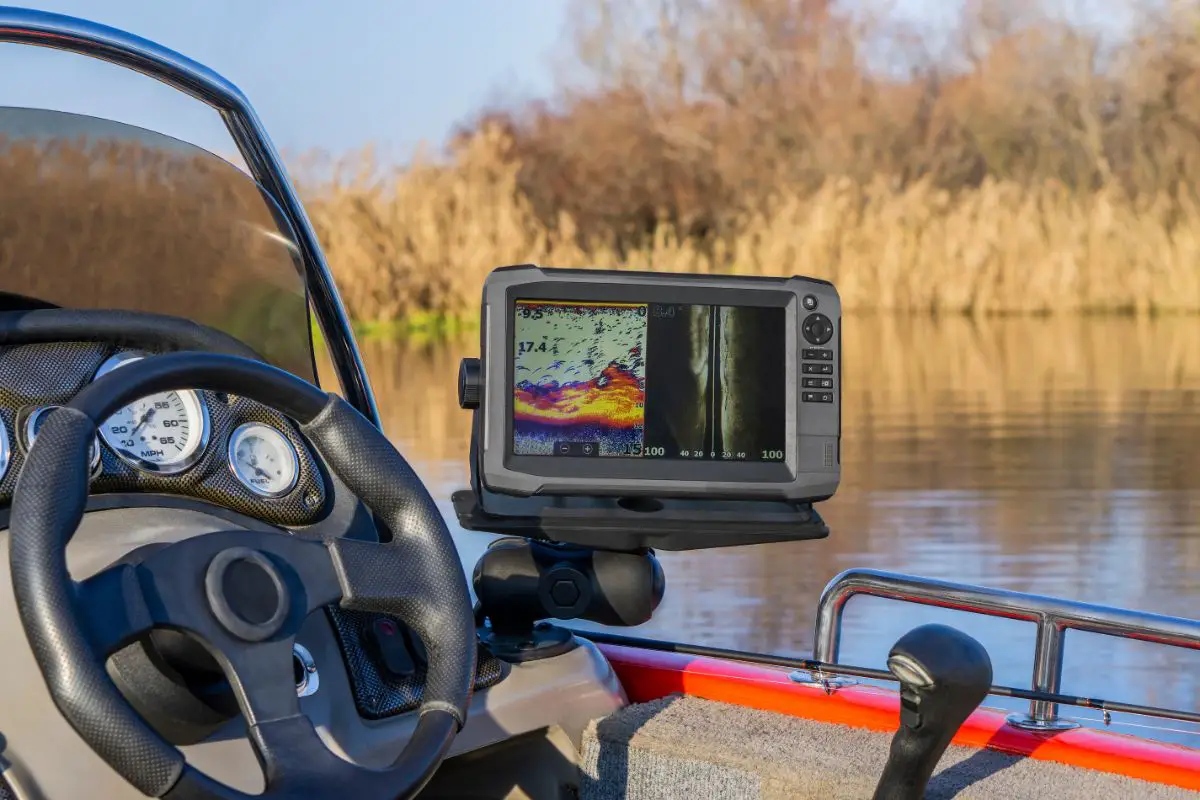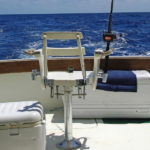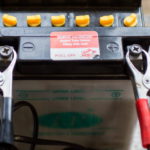Many saltwater anglers depend on fish finders to locate fish and other obstacles while fishing. The fish finder’s transducer detects fish, but the transducer has to be mounted in an optimal position on your boat to get great results. Each boat type has a different position best for mounting a transducer, including pontoon boats.
This article will discuss the best location to set up a transducer in a pontoon boat and how to install it. But first, we will discuss what a transducer is and the different types of transducers.
Note: most links in this article are Amazon.com Affiliate links, see Affiliate Disclosure, thank you.
What is a Fish Finder Transducer?
Fish finding systems have two components: the transducer and the display. Both are connected over WiFi or via cables. The screen visually represents what is under your boat, including where fish and underwater structures are.
The transducer scans the water with beams of waves, interprets the response, and translates it into images displayed on the screen. Fish finders locate fish underwater, allowing anglers to make a more accurate casting. They are used to detect non-visible hazards in the water, work out the depth of the water, and detect fish targets and objects such as fallen trees.
Types of Fish Finder Transducers
Transducers are not all the same. Based on their mount, there are four types of transducers: thru-hull, transom mount, in-hall, and trolling motor.
Thru-Hull
A thru-hull transducer connects to a boat via holes drilled into the boat’s hull. It has a nylon, threaded bronze, or stainless steel shaft passed through the hull’s bottom. And it is usually used for inboard engine models. Thru-hull transducers are more efficient on flat surfaces and work excellently at different speeds.
They are installed at an angle parallel to the water’s surface and usually require a tilt of 5 to 10 degrees to provide an accurate depth measurement. Thru-hull transducers are semi-flush or flush mounted and are usually shaped like a football. They may be difficult to install but offer excellent signal quality.
Transom Mount
Transom transducers connect to the transom instead of the hull. As a result of this layout, they only perform well at slow speeds. When sailing at high speeds, they create some drag and may not work properly when the boat is on a plane. This is because the turbulence made by the transom, hull, and strakes causes interference. They are sensitive, have a deep range, and can easily adapt to almost any hull design.
In-Hull
These transducers are mounted on the inside of the hull’s bottom. They are stuck to the hull using silicone or epoxy and used on vessels with stepped hulls. They are usually installed near the vessel’s centerline, so they are always underneath the water.
Trolling Motor
These transducers are permanently mounted in the propeller hub of the trolling motor and may also be clamped to the outer side. The trolling motor transducer is aimed at the trolling motor’s pedal. Its signal range is horizontal and it has a beam that you can adjust mechanically. This transducer is more expensive because the technology is relatively new.
Best Place to Mount a Transducer on a Pontoon Boat
After getting a fish finder and its transducer, the next task is to figure out where to place it on your pontoon boat. Many people put their monitors on their consoles to gain visuals and easy access while searching for an excellent fishing spot. It’s crucial to place the transducer near the monitor. Too much distance between the monitor and transducer may result in a signal that is too weak and there may be electrical interference.
Generally, the best place to install your transducer is on the starboard side of your pontoon boat. You want to ensure the cord length to connect the transducer to the monitor in the console is sufficient. To face little hassle or trouble while doing this, mount the transducer on the same side as the fish finder monitor, which is usually the right-hand side.
Aside from choosing the side you’re mounting your transducer on, you must choose a great spot on the pontoon boat for mounting. Fortunately, the layout of pontoon boats makes it easy to choose an excellent spot. You can install the transducer under the pontoon in a place close to the console. There are brackets on the back of pontoon tubes and they are a great location to install your transducer and keep it close to the monitor.

How to Install a Fish Finder on a Pontoon Boat
Choose where to Mount the Transducer
The starboard side is the right place to mount the transducer for pontoon boats.
When placing the transducer, ensure it is far away from other wires to avoid electrical interference.
Determine Monitor Placement
The monitor is usually mounted on top of the cockpit console. If it seems your console doesn’t have ample space for a monitor, buy a screen with a reduced size. Once you’ve determined where your monitor will be placed, check under the console to ensure none of the other wires will get in the way.
Mount and Install the Transducer
This is the easiest part of the installation process. Get a drill bit and drill through the mounting bracket in two places. Attach the transducer mount through the holes and secure it using stainless steel bolts and nuts. Put the transducer cord into the electrical conduit to protect it. Then, pull it up through the side of the boat.
Mount and Install the Monitor
Place the monitor brackets in the desired position, mark the spots you want to drill, then drill through. Use rubber washers between the console’s fiberglass and the mount to reduce rattling and prevent the console from getting scratched by the bracket. Next, put the bolts in the holes and tighten them. Lastly, drill an extra hole behind the bracket for you to put the transducer cord and power cable through.
Tie into the Power
You may either use the fuse box or go straight to the battery. Connecting into the fuse box is easier, as you only need to tie it into power connector plugs. Some boats have fuse boxes with empty plugs. If your boat has these, installing the fish finder will be much faster. It is also possible to add a small battery next to your fish finder, completely separate from your other boat’s electrical components.
Conclusion
Many pontoon boat owners have their fish finder transducer installed on the boat’s starboard side. This is an excellent location for the installation of the transducer. Remember to avoid putting too much distance between the transducer and monitor when mounting your fish finder. We hope you have fun while mounting and installing.



